How to Grow Ladyfinger (Okra) at Home Complete Guide
(Bonus: Grow Coriander With It in the Same Grow Bag!)
There’s something incredibly satisfying about growing your own vegetables at home.The fresh flavor the organic quality and the simple joy of harvesting something you’ve nurtured from seed—it’s a rewarding experience every time.And if you’re like me and love okra (also known as ladyfinger or bhindi)then growing it at home is a must.
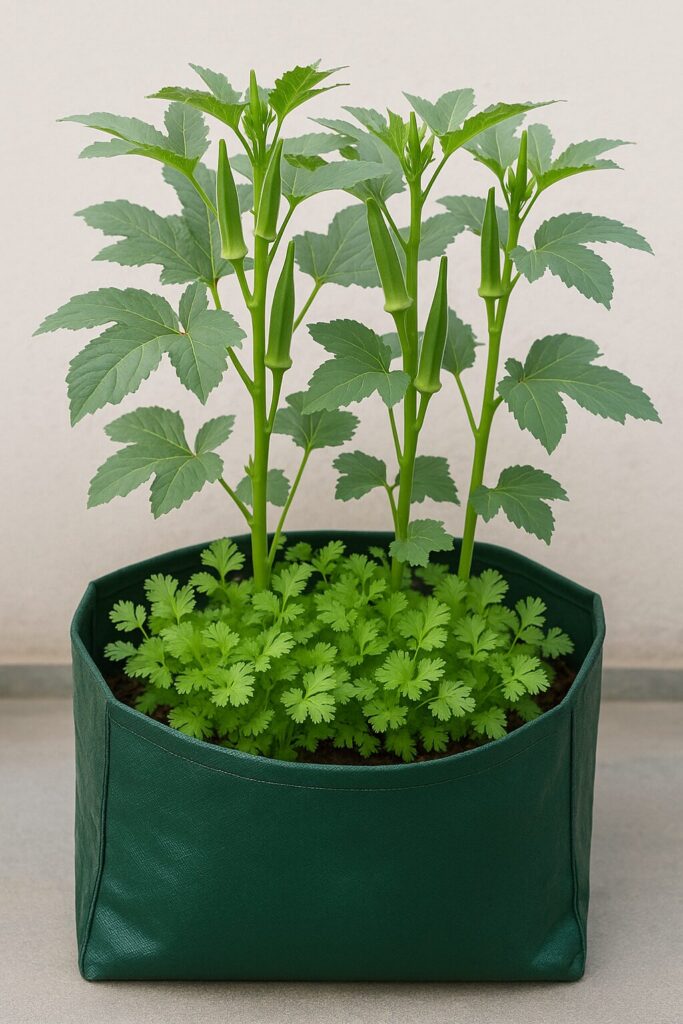
In this guide I’ll show you exactly how to grow okra from seed in a grow bag and, as a bonus, how to grow coriander (dhania) alongside it.It’s the perfect example of companion planting—a method where one plant benefits another when grown nearby. While okra grows tall, coriander which remains short thrives in the shade below.By the time your okra plants mature your coriander will already be ready for harvest.
So let’s get started!
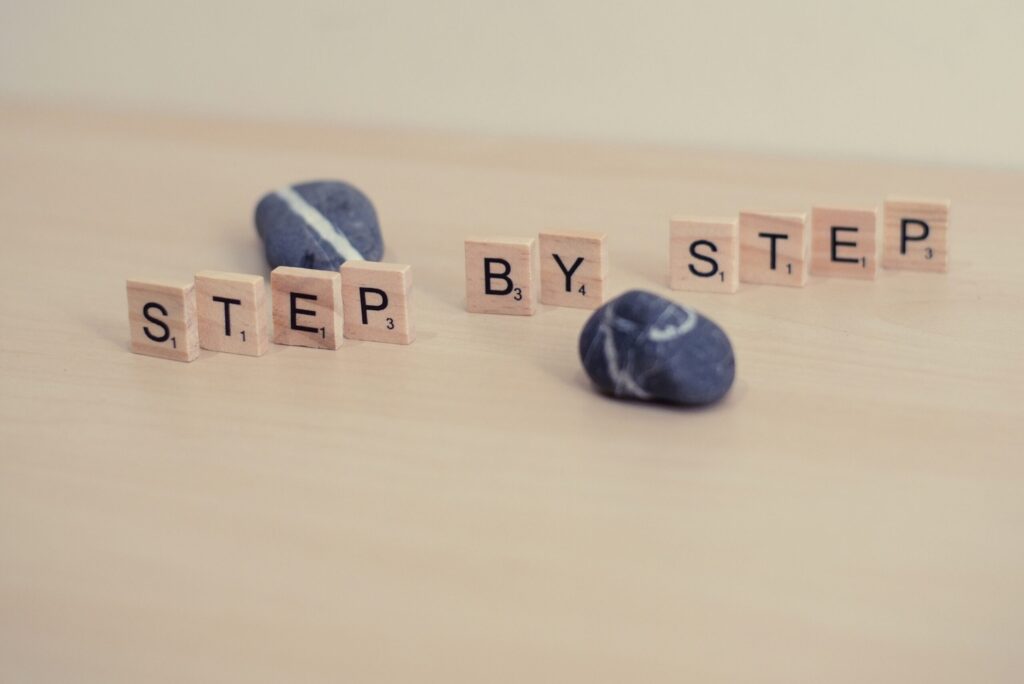
Why Grow Okra and Coriander Together?
This duo is the perfect match for small-space or balcony gardening.Okra grows upward while coriander sprawls low covering the soil and reducing weed growth.They don’t compete much for sunlight or nutrients making them ideal grow bag partners.
By the time the okra plants begin to need more space and sunlight, the coriander is ready to be harvested—giving you two homegrown vegetables with perfect timing.
What You’ll Need
To grow okra and coriander together here’s what you’ll need:
A grow bag (recommended size: 24-inch diameter, 12-inch depth)
Organic compost (at least 30–50% of total soil volume)
Vermicompost for additional nutrients
Okra seeds (Desi or Hybrid F1 varieties work well)
Coriander seeds (preferably with a high germination rate)
Shower head watering can
Neem cake or green additives (optional but improves soil health)
Markers or tags to label plants and sowing dates
You can find quality seeds and compost at GreenGarden.pk, where many urban gardeners trust the quality and germination rates.
Step-by-Step: Preparing the Soil
Soil quality is crucial for growing healthy vegetables.Okra loves loamy well drained nutrient-rich soil and coriander prefers moisture retaining but soft soil.
Step 1: Refresh Old Soil
If you’re using soil from last year’s grow bag, make sure to remove any old roots or debris. Sift through it if needed to break up clumps.
Step 2: Add Organic Compost
Add 30% organic compost to old soil—or 50% if you’re starting with fresh soil. Mix it thoroughly, especially the top 3 inches where roots and seeds will establish first.
Step 3: Mix in Vermicompost and Premium Organic Mix
Top up the grow bag with a blend of vermicompost and premium compost.
The result? Soft, crumbly soil full of life. And it smells healthy too—exactly what your seeds need!
Soaking the Seeds (Optional but Recommended)
Before sowing soak your okra and coriander seeds overnight in room-temperature water.This helps soften their outer shells and speeds up germination.Skipping this step won’t stop them from growing but you’ll notice a delay of several days as the soil works to naturally break down the seed coats.
In this case, we skipped soaking to show what sowing dry seeds looks like. Just remember: keep the soil consistently moist to avoid any germination issues.
Sowing the Seeds
Now for the fun part—planting!
Step 1: Water the Soil the Night Before
Moisture is key. Watering the night before helps ensure the soil is hydrated without being soggy. It also creates an ideal environment for seeds to wake up and start sprouting.
Step 2: Planting Okra
Okra seeds are fairly large and should be planted about half an inch deep spaced 10 to 12 inches apart.In a 24-inch grow bag, you can plant around 14 seeds.Even if some fail to germinate, you’ll have backups.
Use your fingers to gently press each seed into the soil cover with a light layer and pat it down.
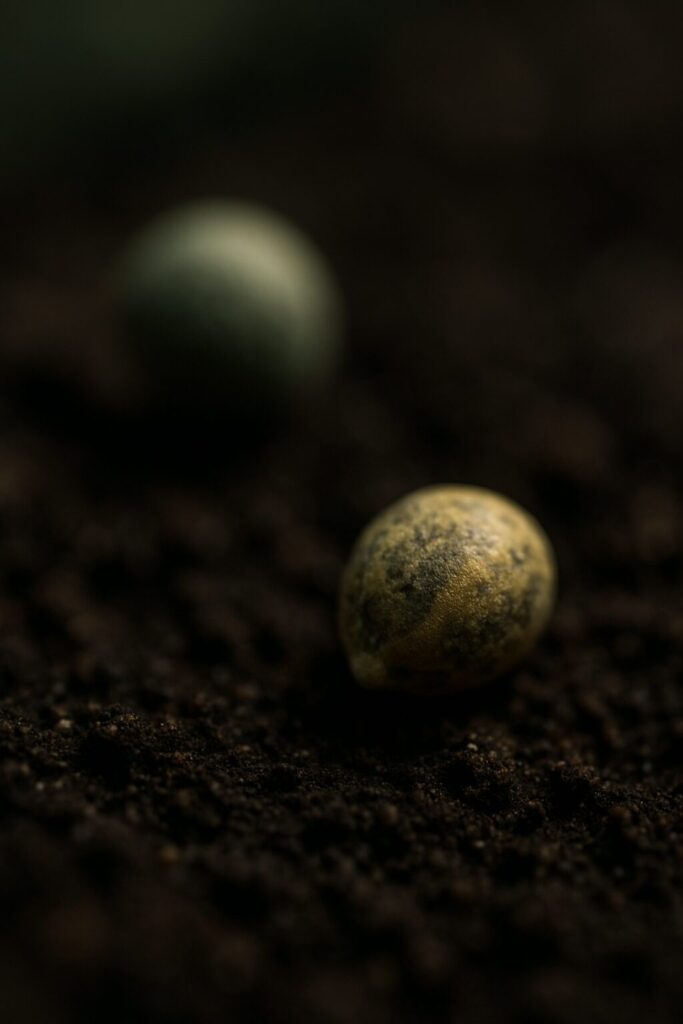
Step 3: Planting Coriander
Coriander seeds are much smaller, so they don’t need to go as deep.Sprinkle them lightly between the okra seeds and around the edges of the grow bag. Cover with a very thin layer of soil—just enough so no seeds are visible.
Tip: Birds love coriander seeds so don’t leave them exposed or you’ll lose your crop before it even starts!
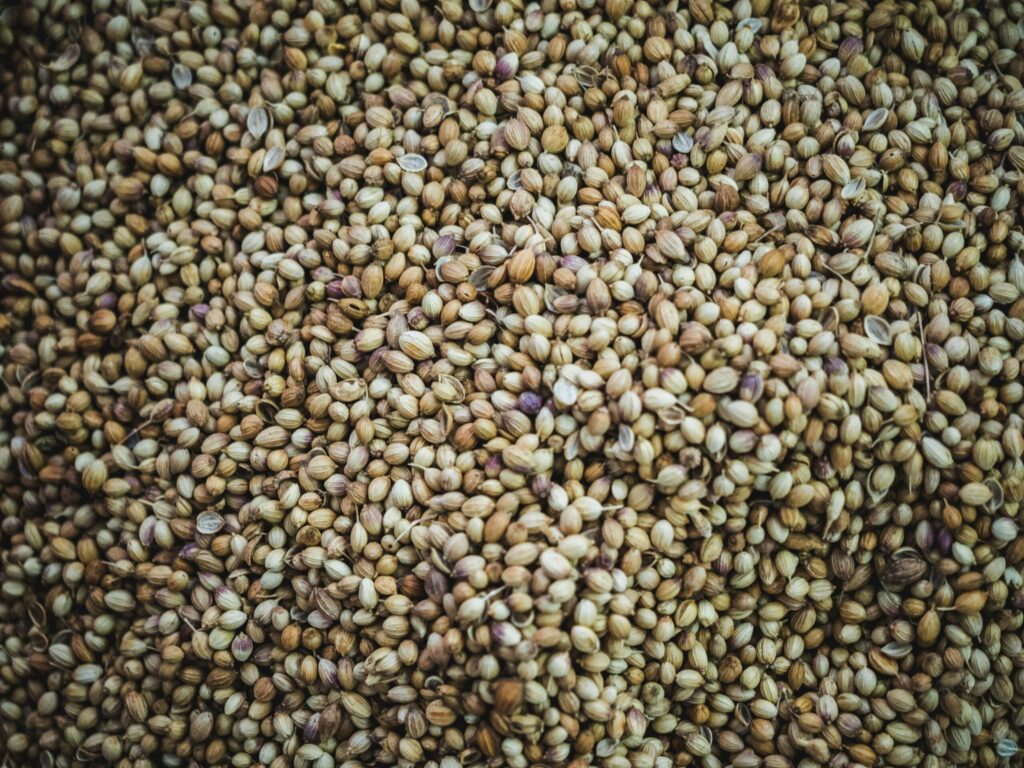
Watering and Moisture Management
The one mistake new gardeners make is inconsistent watering.Here’s the key rule: keep the soil evenly moist but not waterlogged.A shower head watering can is ideal for this as it distributes water gently and evenly.
Too much water will rot seeds.Too little water and they’ll think it’s not safe to grow.Strike a balance and you’ll see healthy sprouts in a few days.
Ideal Temperature and Timing
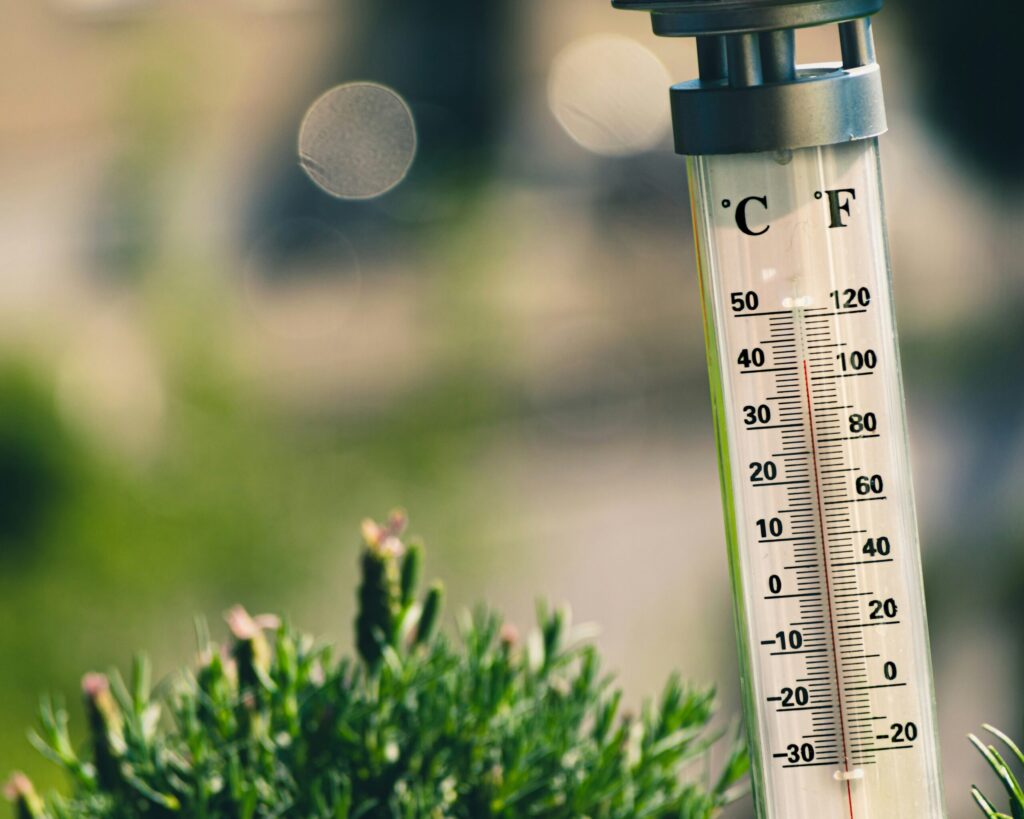
March is a great time to plant okra and coriander in most regions.As long as night temperatures don’t drop below 10°C seeds should germinate well.Check your local weather forecast before sowing.
In our case we planted on March 8, and conditions were ideal. Within 7–10 days you’ll start to see life!
Using Plant Tags
Here’s a simple trick to make your garden smarter: cut your seed packet attach it to a stick and label it with the date of sowing or your name.This helps you track germination timelines and see which seeds perform best over time.
Harvest Timeline
Coriander: Ready for harvest in 3 to 4 weeks after planting. You can snip leaves as needed or harvest the entire plant.
Okra: Begins fruiting in about 45–60 days. Harvest when the pods are 3 to 4 inches long—before they get too tough.
Harvest regularly to encourage the plant to keep producing!
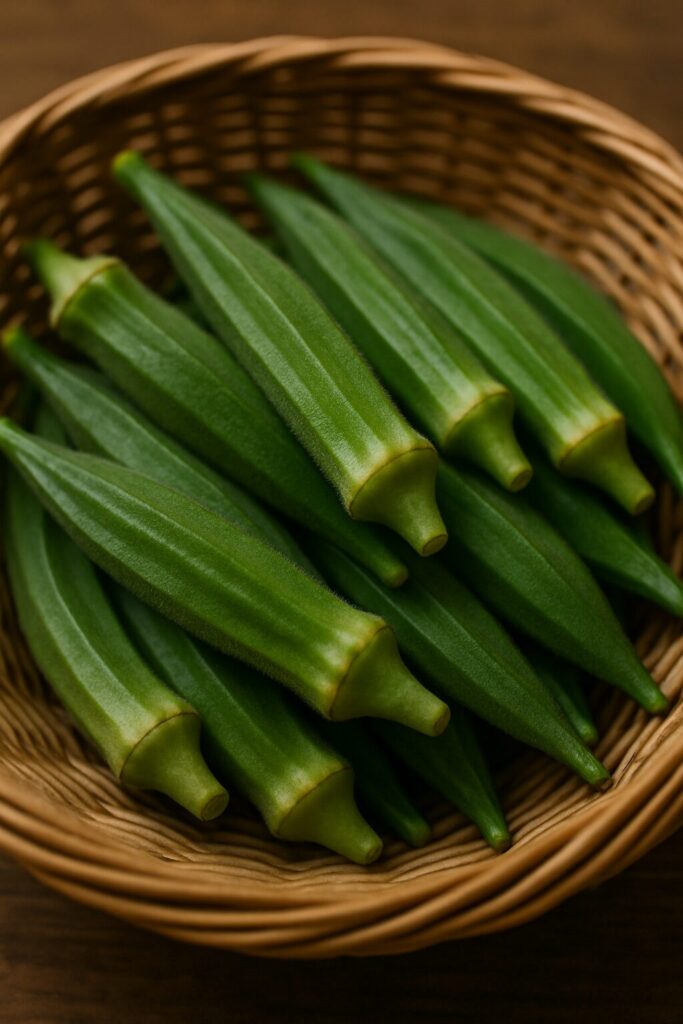
Common Issues and How to Avoid Them
No germination? Check watering levels. Dry patches or soaked areas can delay or stop sprouting.
Yellowing leaves? This could be poor soil drainage or overwatering.
Pests? Neem oil spray works wonders and is safe for edible plants.
Final Thoughts: Why Homegrown Is Best
The taste the texture the health benefits—homegrown vegetables just hit different. No chemicals, no preservatives—just clean water clean soil and your own two hands.It’s fresher safer and frankly more fun than anything you can buy in a store.
Growing okra and coriander together is not just a smart space-saving technique—it’s a simple way to double your harvest and your happiness.Whether you’re gardening on a balcony patio or backyard, this method works beautifully.
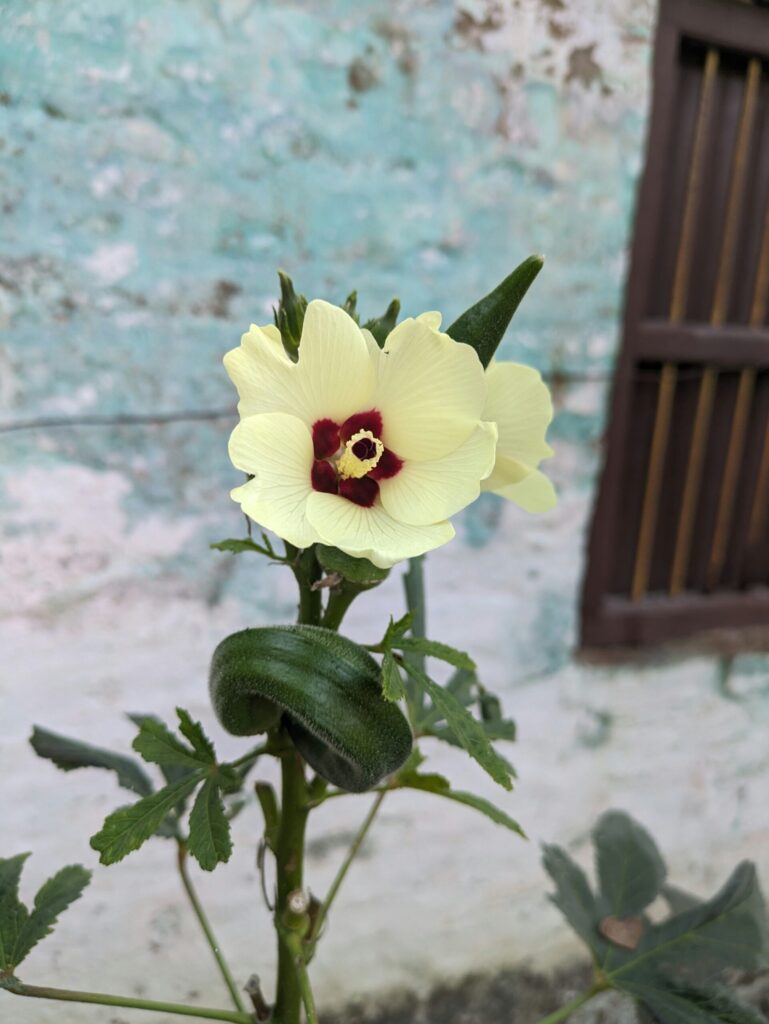
FAQs – How to Grow Okra (Ladyfinger) and Coriander in Grow Bags at Home
🌱 How to grow okra (ladyfinger) at home in grow bags?
You can easily grow okra in a 24-inch wide and 12-inch deep grow bag. Use rich, loamy soil mixed with compost, water consistently, and place the bag in a sunny spot. Okra is great for small-space or balcony gardening.
🌿 Can I grow coriander and okra together in one grow bag?
Yes! Growing coriander with okra is an excellent example of companion planting. Coriander stays low and matures quickly, while okra grows tall and slow, so they work really well together without competing.
🗓️ What is the best time to plant okra and coriander at home?
The ideal time is early spring, especially during March, when temperatures stay above 10°C at night. Warm, consistent weather helps both seeds germinate successfully.
💧 Should I soak okra and coriander seeds before planting?
Soaking seeds overnight in room-temperature water can speed up germination. It’s not essential, but it does help get things going faster.
📏 How deep should I plant okra and coriander seeds in containers?
Plant okra seeds about ½ inch deep and space them 10–12 inches apart. Coriander seeds can be lightly sprinkled on the surface and gently covered with a thin layer of soil.
🚿 How often should I water potted okra and coriander plants?
Keep the soil evenly moist but not waterlogged. A gentle shower from a watering can helps avoid disturbing the seeds. Consistency is key to healthy sprouts.
🌾 What is the best soil mix for growing okra and coriander in containers?
Use a mix of loamy soil with 30–50% organic compost and some vermicompost. This blend provides the right balance of drainage and nutrients for both plants.
⏳ How long does it take to harvest coriander and okra at home?
Coriander is ready for harvest in about 3–4 weeks. Okra takes 45–60 days to start producing. Harvest okra pods when they’re 3–4 inches long to keep them tender.
🐛 What are common problems in homegrown okra and coriander plants?
- 💧 No sprouts? It might be due to dry or soggy soil.
- 🍂 Yellowing leaves? Usually caused by poor drainage or overwatering.
- 🦟 Pests? A neem oil spray works well and is safe for edible plants.
♻️ Can I reuse soil in grow bags for the next season?
Definitely. Just remove any old roots, loosen the soil, and mix in fresh compost or vermicompost. You can also add natural soil conditioners like neem cake to improve quality.
🛒 Where can I buy seeds and compost for container gardening?
You can find seeds and compost at local nurseries or online gardening stores. Look for high-germination seeds and organic compost blends for best results.
🏡 Why should I grow vegetables like okra and coriander at home?
Homegrown veggies are fresher, chemical-free, and taste way better than store-bought. Plus, it’s a satisfying hobby that connects you with nature and your food.
A Brief History of Okra
Okra often called ladyfinger has roots that stretch back thousands of years.Most historians agree it first grew in the fertile lands of Ethiopia and Sudan long before it spread across the world. Ancient Egyptians were among the first to cultivate it loving its tender pods and unique texture.
From Africa okra traveled along ancient trade routes into the Middle East and the Mediterranean.By the 12th century it had found a second home in India, blending beautifully into local cuisines. Thanks to its tolerance for heat and drought, okra thrived wherever it was planted.
Okra made its way to the Americas during the dark era of the transatlantic slave trade. Enslaved Africans carried okra seeds across the ocean, planting them in the unfamiliar soils of the southern United States.Over time okra became a cornerstone of Southern cooking especially in famous dishes like gumbo—a word rooted in African languages.
Today whether it’s stewed fried, or added fresh to a salad okra remains a favorite in kitchens around the world.Its journey through history isn’t just about farming it’s a story of resilience tradition and flavor passed down through generations.
Medical Benefits of Okra (Ladyfinger)

When it comes to health benefit okra is truly a hidden gem.This humble vegetable is packed with soluble fiber making it great for digestion and helping to stabilize blood sugar levels over time. Thanks to its rich antioxidant content okra also plays a role in protecting the heart and keeping cholesterol in check.It’s loaded with vitamin C which gives your immune system a solid boost and supports healthier, more radiant skin. And if you’re watching your weight okra low calories and high fiber help keep you feeling full longer without overdoing it.Its vitamin A and beta-carotene are a blessing for your eyes promoting good vision as you age. Plus, the natural anti-inflammatory compounds in okra offer gentle relief for joint pain and stiffness.Expecting mothers can especially benefit from its folate which supports healthy baby development.One more amazing thing? The sticky, mucilaginous texture of okra actually binds to toxins in the gut helping your body cleanse naturally. With so much packed into such a simple vegetable, okra deserves a lot more love on our plates.
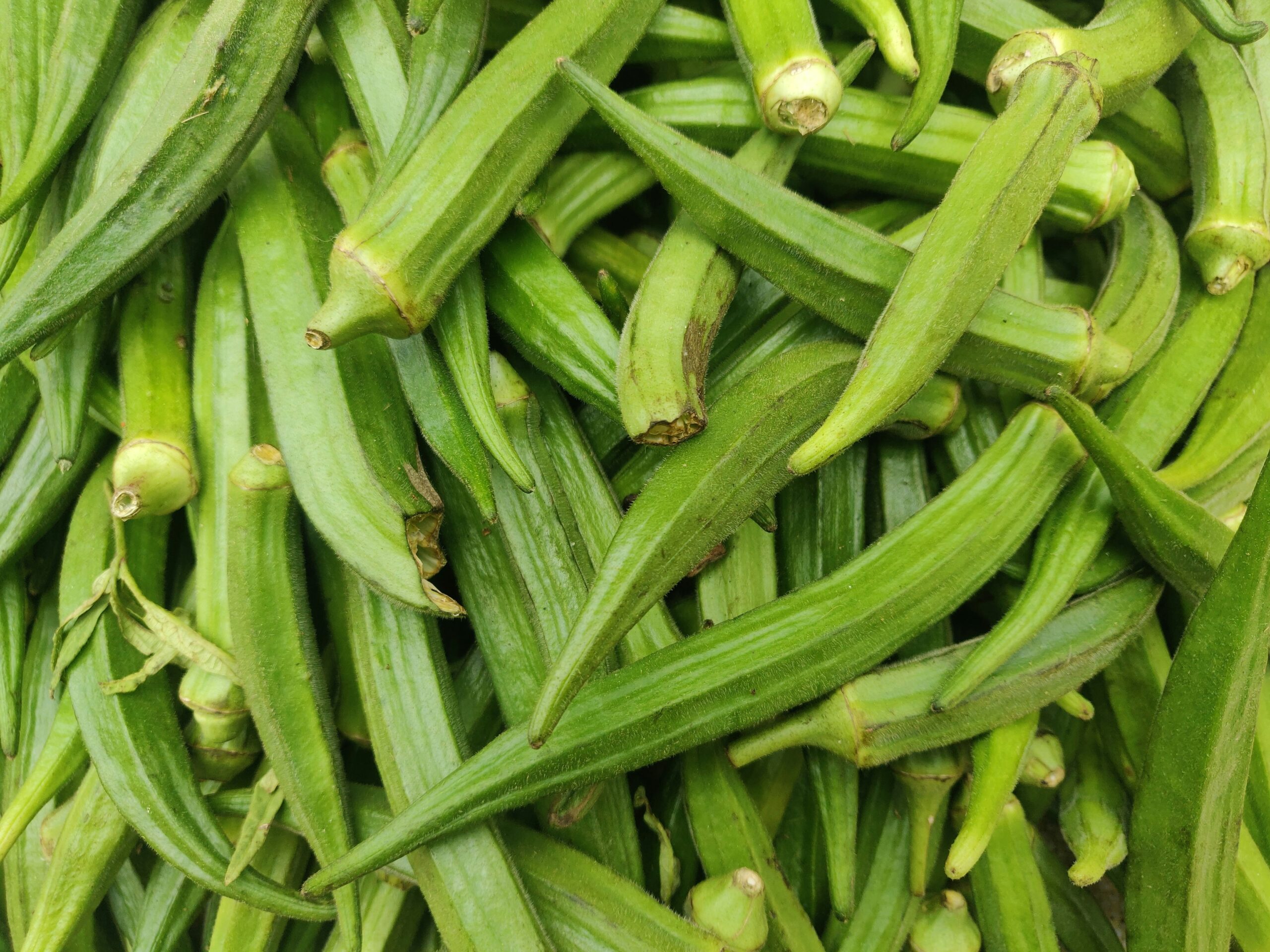
Leave a Reply